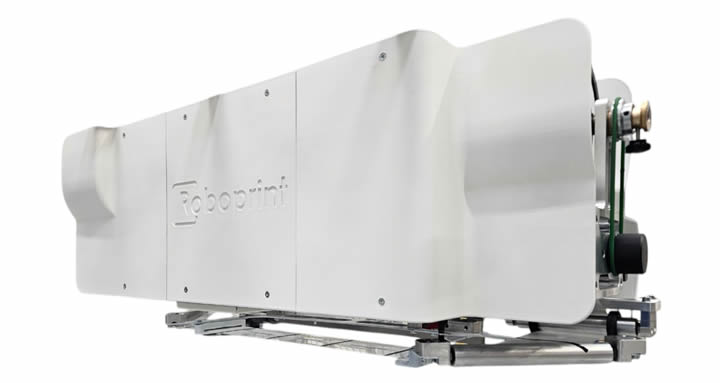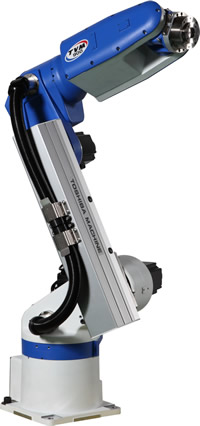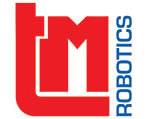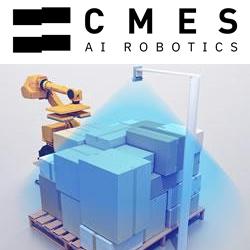The collaboration between Roboprint, Shibaura Machine and TM Robotics illustrates how partnerships between emerging innovators and established suppliers can help the plastics industry adapt to new demands.
Decorating plastics with robotic precision
Article from | TM Robotics
Plastics decoration has long depended on pad and screen printing — reliable but hindered by solvents, labour-intensive changeovers and downtime for design changes. In fast-moving markets with shifting consumer expectations and shorter product lifecycles, these methods are under strain. Italian start-up Roboprint, in partnership with Shibaura Machine and European distributor TM Robotics, has developed T-TRANSFER, a system that combines pre-printed transfer reels with robotic automation to overcome many of these limitations.
Consumer interest in personalisation is reshaping manufacturing. A Deloitte survey in 2024 found that one in five consumers interested in personalised products or services are willing to pay a 20 per cent price premium. This demand has accelerated adoption of digital printing technologies, which allow shorter runs and customised designs.
However, pad and screen printing remain dominant in high-volume manufacturing. They are resource-intensive processes that depend on solvents and varnishes, require frequent operator intervention and can generate significant waste. At the same time, regulation and consumer sentiment are converging around sustainability.
The same Deloitte research reveals that nearly three-quarters of brands now promote circular economy principles, while 85 per cent of consumers globally say they have shifted towards greener purchasing in the past five years. These pressures are forcing companies to re-examine legacy decoration methods.

Roboprint’s T-TRANSFER system combines pre-printed transfer reels with robotic precision to decorate complex 3D plastic surfaces sustainably.
From concept to development
The origins of T-TRANSFER can be traced back to 2022, when Roboprint was presenting its T-ROBOT pad printing system at the MECSPE trade fair in Bologna, Italy. During the exhibition, Roboprint’s founder, Valter Scolaro, and commercial manager, Martina Scolaro, met Nigel Smith, managing director of TM Robotics.
“We were already looking at how to take pad printing further,” Scolaro recalls. “The idea was to combine our printing expertise with robotic movement to achieve greater flexibility and consistency. When we spoke to Smith, he immediately encouraged us to push the concept forward.”
Smith agrees that the conversation stands out. “It was clear that Roboprint was approaching decoration in a new way,” he says. “The idea of combining their print heads with Shibaura robots had huge potential to solve long-standing challenges in the industry.”

The heated silicone pad in Roboprint’s T-TRANSFER process adapts to intricate geometries, transferring designs directly at the moulding press.
That meeting led to collaborative trials with TM Robotics’ Italian distributor, Tiesse Robot, and integration partner BBS robot, as well as further demonstrations at Shibaura Machine’s Solution Fair, held at its headquarters in Japan. Those early successes gave the partners the confidence to move ahead with development. The result is a patent-pending system that integrates a heated silicone pad with a Shibaura Machine robot, for example the TVM900 6-axis.
At the core of the system is a heated silicone pad mounted on the robot. The flexible pad adapts to three-dimensional geometries, transferring pre-printed images onto surfaces that are often difficult to decorate using traditional methods. Instead of relying on inks applied on-site, the system uses reels of pre-prepared transfers supplied on protective silicon paper. These reels can be stored for up to twelve months and are loaded into the machine as needed. Decoration is achieved with controlled heat and pressure, producing a consistent and durable finish.
Scolaro explains that this approach simplifies integration into existing processes: “One of the key advantages is that decoration can take place directly at the moulding press,” she says. “Instead of moving parts to a separate finishing department, we can apply the decoration as soon as the component leaves the mould. This shortens production and reduces risk of damage.”
Addressing sustainability challenges
 Because it relies on pre-printed reels rather than liquid inks, the process removes the need for solvents, varnishes and catalysts.
Because it relies on pre-printed reels rather than liquid inks, the process removes the need for solvents, varnishes and catalysts.
“This has big implications for operators,” Scolaro says. “They don’t need to handle chemicals or carry out lengthy cleaning cycles, which makes the whole process safer and more predictable.”
The reels are recyclable, and the decoration does not affect the recyclability of finished parts, allowing them to enter conventional recycling streams. Energy savings are also part of the picture. The heated pad doubles as both applicator and pretreatment tool — removing the need for flaming, plasma or corona discharge, all of which add complexity and cost. According to Roboprint’s internal testing, cycle times are typically five to six seconds per part, depending on geometry and material.
Valter Scolaro adds that sustainability has been a driving factor from the outset: “We knew that decoration had to become greener,” he says. “By eliminating solvents and reducing energy demand, we are aligning with both regulation and customer expectations.”
The Shibaura Machine TVM900 6-axis robot integrates seamlessly with Roboprint’s print head for high-speed, automated decoration.
Flexible applications
 Flexibility is another distinguishing feature. Because the designs are pre-printed onto reels, manufacturers can switch between logos, colours and patterns without halting production. Multiple decorations can also be applied to different areas of a single part in one cycle — something that is almost impossible with pad or screen printing.
Flexibility is another distinguishing feature. Because the designs are pre-printed onto reels, manufacturers can switch between logos, colours and patterns without halting production. Multiple decorations can also be applied to different areas of a single part in one cycle — something that is almost impossible with pad or screen printing.
“For industries like automotive, where a component such as a dashboard or control panel might need several precise decorations, the ability to do this in one automated step is a real advantage,” Scolaro says. “The same is true for consumer goods, where manufacturers are under pressure to deliver variety quickly.”
Roboprint develops the print head, while Shibaura Machine engineers ensure it can be integrated with their robots, such as the TVM900 and controllers like the TSL3200E. Direct communication between the system and the robot controller synchronises pad movements with robotic positioning, ensuring accuracy and repeatability. TM Robotics, as Shibaura’s European distributor, has provided commercial expertise and technical support.
The roll-out of T-TRANSFER includes demonstrations of the technology, such as at the K 2025 exhibition in Düsseldorf, Germany, billed as the world’s number one trade fair for plastics and rubber. These displays show the integration between RoboPrint’s transfer printing head and the Shibaura TVM900 6-axis robot, with 900 mm reach and 20 kg payload, decorating products like business card holders and more complex 3D surfaces.
“When people see the system in action, they understand how it can change their process,” Scolaro says. “The feedback so far has been overwhelmingly positive.”
A Shibaura TVM900 robot applies multiple decorations in a single cycle, demonstrating accuracy and flexibility in plastics finishing.
Future directions
Roboprint and its partners are already considering the next phase of development. One proposal is the intelligent logo, in which transfers incorporate Radio Frequency Identification (RFID) tags or sensors capable of storing and transmitting data. This would allow components to be tracked through the supply chain, support authenticity checks or monitor the use of safety equipment.
“This is about decoration becoming part of the digital identity of a product,” Scolaro explains. “From recycling data to traceability, there are many possibilities once you start embedding information directly into the decorated surface.”
Such concepts align with wider industry trends towards digital manufacturing and regulatory changes, including the introduction of Digital Product Passports under the European Union’s Ecodesign Regulation. These passports will require detailed information on product composition and recyclability. By embedding this information during decoration, manufacturers could simplify compliance and improve supply-chain transparency.
T-TRANSFER reflects the wider move in manufacturing towards processes that combine efficiency, flexibility and sustainability. While pad and screen printing are unlikely to disappear overnight, innovations that reduce chemical use, cut waste and integrate more seamlessly into production cycles are likely to attract growing attention.
The collaboration between Roboprint, Shibaura Machine and TM Robotics illustrates how partnerships between emerging innovators and established suppliers can help the plastics industry adapt to new demands.
As Smith observes: “This is a technology that bridges tradition and the future. It respects the need for durable decoration while answering the call for greener, more flexible production.”
To learn more about T-TRANSFER and Shibaura Machine robots, visit the TM Robotics website.
The content & opinions in this article are the author’s and do not necessarily represent the views of RoboticsTomorrow

TM Robotics (Americas) Inc
TM Robotics, in partnership with Shibaura Machine, formerly known as Toshiba Machine until 1st April 2020, offers a comprehensive range of industrial robots ideally suited for high-precision assembly, machine loading/unloading and material-handling applications that can be dust proof, clean room, or IP65/67. The company's extensive product line starts with a Cartesian solution available in thousands of combinations from single actuators to four-axis solutions; six-axis solutions that can include precise vision-control; and a complete range of SCARAs from low cost to the industry-leading SCARA with 1200-mm reach that can carry up to 20 kgs. TM Robotics sells and services robots throughout Europe, the Middle East, India, Russia, and Africa, as well as North, Central, and South America, from headquarters in Hertfordshire, England and Elk Grove Village, IL, USA. For more information, visit www.tmrobotics.com or follow us on Twitter, LinkedIn and YouTube.
Other Articles
Giving lens cleaning cloths a robotic hand - Robotic automation for textile processing
Investing in the UKs injection moulding sector - The case for all-electric machines and robotic integration
Robotic solutions for pharmaceutical packaging - Automated system addresses key limitations of manual processes
More about TM Robotics (Americas) Inc
Featured Product

